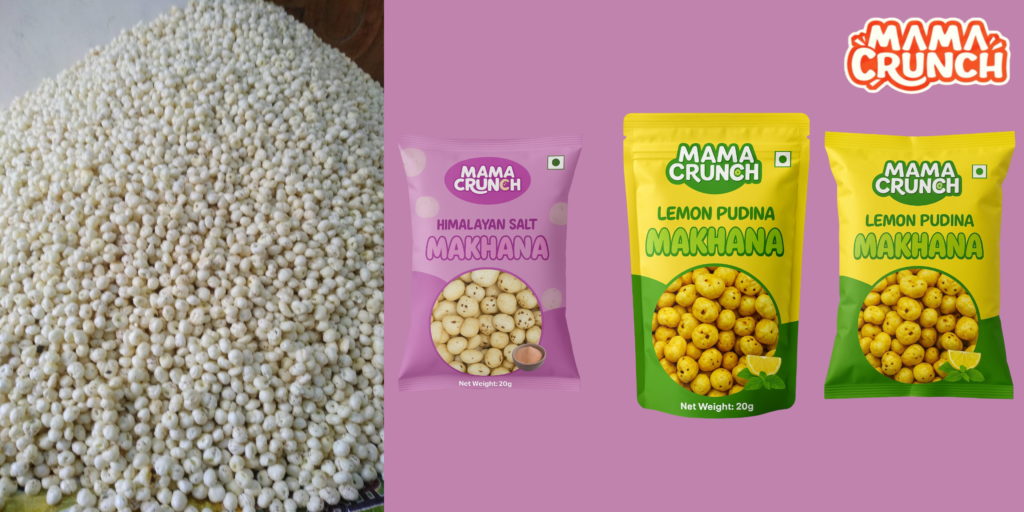Because of its high nutritional content and inherent qualities, makhana, often referred to as fox nuts or lotus seeds, is quickly gaining popularity as a superfood worldwide. Best Makhana Export Price in India. The makhana export industry has grown significantly in recent years due to rising demand from health-conscious consumers. Because of this, importers and exporters worldwide keep a careful eye on import taxes, trade regulations, and makhana prices in various nations.

To assist importers and purchasers in making wise choices, we offer a comprehensive summary of makhana exporter pricing in some nations in this blog and a price sheet that can be downloaded.
What Is Makhana?
Over 90% of the world’s supply of makhana, the popped seed of the Euryale ferox plant, is grown mostly in the Indian state of Bihar. It is prized for its:
- High levels of fibre and protein
- Low-fat and calorie intake
- Gluten-free
- Ayurvedic qualities
Makhana is utilised extensively in foreign markets for snacks, cereals, candies, and even cosmetics because of its nutritional advantages.
Global Demand for Makhana:
Countries including the Makhana Export Price USA, UK, UAE, Australia, Canada, Germany, Singapore, and Japan have seen a sharp increase in demand for makhana. Among the main causes are
- Growing knowledge about superfoods
- Trends toward veganism and gluten-free eating
- Growing demand for healthy snack products
- Popularity of traditional medicine and Ayurveda
International orders for Indian exporters, especially those from Bihar and Uttar Pradesh, have increased by 25–40% a year.
Factors Affecting Makhana Export Prices:
Quality Grade: Makhana comes in a variety of classes depending on its size, colour, and puffiness. Higher costs are paid for seeds that are larger and more consistent.
Processing Type: Price is affected by whether makhana is roasted, raw, flavored, or organic.
Packaging Guidelines: Because of quality control, makhana that is vacuum-sealed or nitrogen-packed for export is more expensive.
Costs of shipping differ according to the nation, port, and logistics partner.
Tariffs and Import Duties: Trade policies vary among nations.
Currency fluctuation: FOB (free on board) and CIF (cost, insurance, and freight) prices are impacted by the USD-INR and other exchange rates.
Average Exporter Price of Makhana by Country (2025) Makhana Export Price
Here is an approximate price comparison (in USD) per kilogram for raw premium-grade makhana exported from India, based on bulk orders of 1,000 kg or more:
| Country | FOB Price per KG (USD) | CIF Price per KG (USD) | Popularity Rank | Notes |
|---|---|---|---|---|
| United States | $4.20–$5.80 | $4.00–$5.50 | High | Strong demand in vegan snacks |
| United Kingdom | $4.50–$6.00 | $5.50–$7.00 | High | Organic makhana is popular |
| Canada | Strong demand for vegan snacks | $6.00–$7.50 | Moderate | Distributed via health chains |
| Australia | $6.50–$7.80 | $4.50–$6.50 | Moderate | Snack market growing |
| Germany | $4.30–$5.90 | $6.00–$7.70 | Moderate | Clean label preference |
| UAE | $6.50–$8.00 | $3.80–$5.00 | High | Strong Indian diaspora |
| Singapore | $5.00–$6.50 | $4.00–$5.50 | Growing | Sold in organic stores |
| Japan | $6.00–$7.00 | $4.00–$5.20 | Niche | Slow but rising awareness |
| South Africa | $4.70–$6.20 | $6.80–$8.20 | Emerging | Expanding health food sector |
| France | $5.80–$6.80 | $4.50–$6.00 | Moderate | Increasing demand |
Packaging Options for Export
Exporters generally offer the following packaging for international orders:
- Vacuum Pouches (200g, 500g, 1kg)
- Tin Cans (Flavoured/Spiced)
- Bulk Polybags (25kg)
- Customised Private Label Packaging
How to Choose a Reliable Makhana Exporter:
Take into account the following factors while choosing a Makhana exporter or supplier:
- APEDA & FSSAI Certification.
- Compliance with ISO or HACCP.
- Export evaluations and experience.
- Availability of samples and quality control.
- Competitive prices with clear breakdowns.
- Whether roasted, flavoured, or organic options are available.
Conclusion:
In the worldwide superfood market, makhana has cemented its place, and the trend is anticipated to continue to gain momentum in 2025 and beyond. Exporters have a distinct edge in accessing foreign markets if they can provide international-grade packaging, competitive prices, and superior quality.
Understanding export pricing and supplier dynamics is essential for long-term success, regardless of whether you’re a distributor in Canada, a wholesaler in the United Arab Emirates, or a European brand searching for private-label Makhana.
